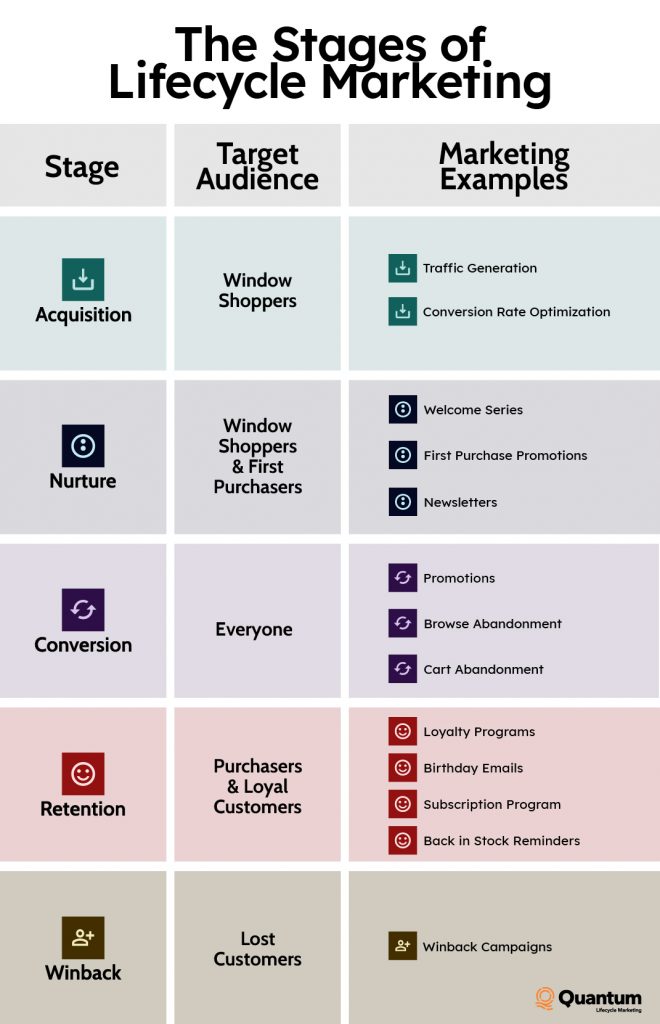In our definition of lifecycle marketing, we mention how lifecycle marketing aims to engage with customers throughout the buyer’s journey. But who has the time to craft a unique campaign for every individual customer?
That’s where segmentation comes into play. Segmentation is the process of grouping subscribers into buckets to target them with personalized campaigns to improve customer engagement.
While there are countless ways to segment subscribers, let’s focus on the basic stages of lifecycle marketing:
- Acquisition
- Nurture
- Conversion
- Retention
- Winback

We’ll walk through the stages of lifecycle marketing in more detail and outline basic marketing tactics related to each.
Down the Full Lifecycle Marketing Ebook
1. Acquisition
The acquisition stage of lifecycle marketing targets window shoppers. Acquisition involves capturing a person’s attention, bringing them to your page, and collecting their email address and phone number for future communication.
Marketing tactics to use during Acquisition:
- Search engine optimization (SEO)
- Paid ads
- Conversion rate optimization (CRO)
Email marketing won’t always work on window shoppers since they haven’t necessarily signed up for your email and SMS list. If that’s the case, you can try retargeting window shoppers with paid ads.
If they have signed up for your email list, then your marketing team can nurture them in hopes that they’ll eventually become single purchasers.
2. Nurture
The nurture stage stretches from acquisition to conversion and targets window shoppers and single purchasers. The main goal during this stage is to build trust and demonstrate authority with your audience.
Marketing tactics to use during Nurture:
- Email & SMS welcome series
- Newsletters
- Conversational messaging
3. Conversion
Conversion is the final push to convince someone to press the buy button.
The biggest challenge here is simply getting someone through the checkout process. Anything from unclear shipping policies to a slow cart experience can derail this process and impact conversion rates.
Marketing tactics to use during Conversion:
- First purchase promotions
- Abandoned cart recovery
- Browse abandonment recovery
- Cross-selling
- Upselling
4. Retention
The retention phase is all about customer experience. So what can you do to ensure the customer makes another purchase, joins your loyalty programs or shares your products online?
Marketing tactics to use during Retention:
- Loyalty programs
- Subscription programs
- Birthday messages
- Back in stock reminders
The ultimate goal during retention is to turn purchasers into loyal customers. Loyal customers do more than buy from you repeatedly. They are part of your community, which means they may take actions such as:
- Signing up for product subscriptions.
- Leaving positive reviews or testimonials.
- Linking to your shop on their own sites or social media pages.
- Talking about you to friends and family.
- Supporting and even defending your brand, acting as an influencer in a way that expands your store’s reach and reputation online.
Loyal customers are extremely valuable because they’re harder to lose (and harder to gain) than any other customer type. Since they are so valuable, treat them like it!
5. Winback
The winback stage is dedicated to ushering lost customers back to your store. The point is to fix any customer experience issues or remind former customers why they loved you in the first place.
Marketing tactics to use during Winback:
- Winback campaigns
- Special return offers
This was a brief outline of lifecycle marketing. In the following chapters of this book, we are going to take a deeper dive and show you how to optimize your email and SMS campaigns for each stage of a customer’s lifecycle. First up: acquisition.
